Kothari D.P., Nagrath I.J. Modern Power Systems Analysis
Подождите немного. Документ загружается.

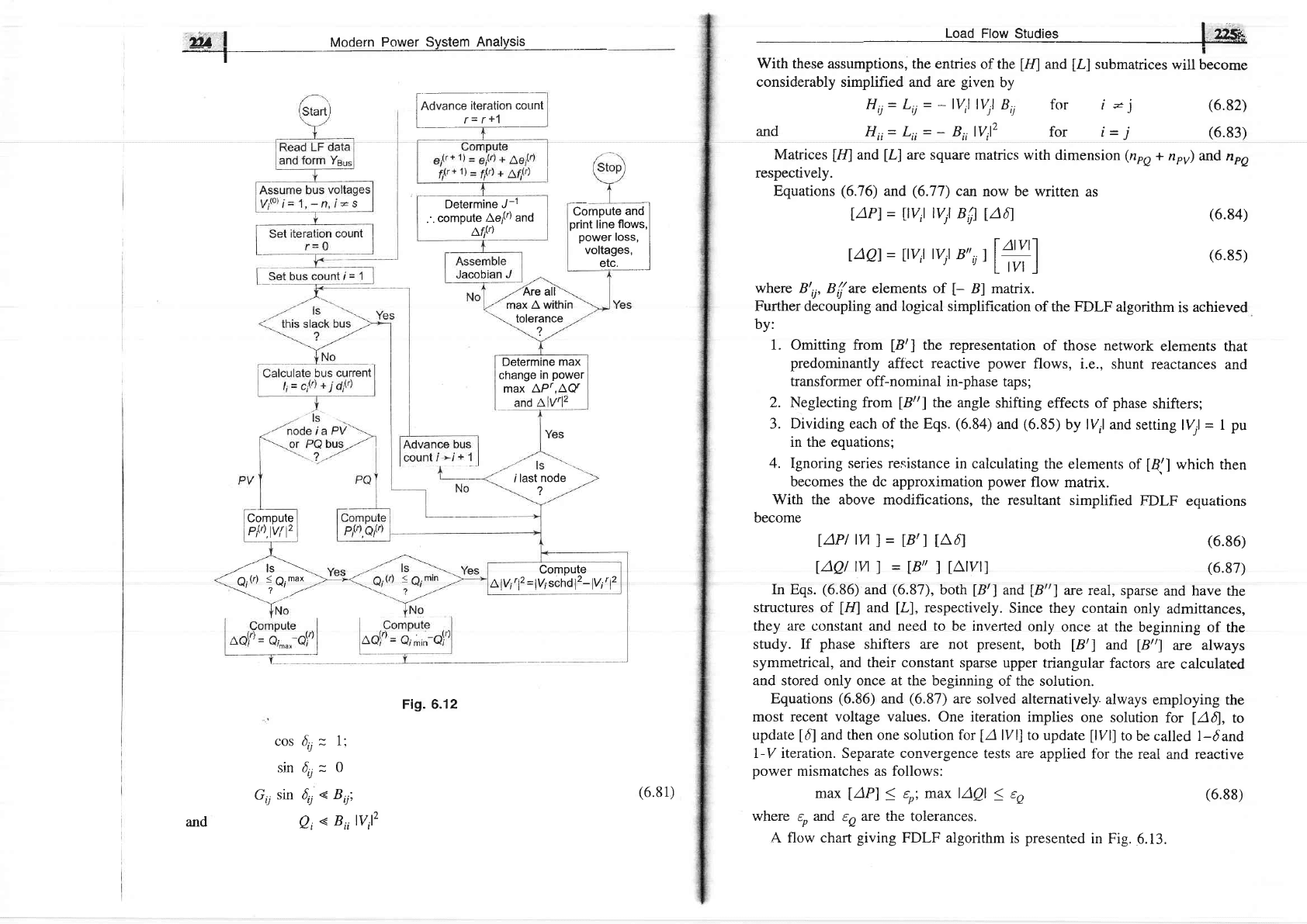
'*i
I vodern Power Svstem Analvsis
-::,:-,t
I
I
zas-
With
these assumptions, the entries
of the
[1{
and
[L]
submatrices
will become
considerably simplified and are
given
by
I
Aduance
iteration
count
I r= r+1
Determine
J-1
.'.
comPute
Aefr)
2n6
Lfiv)
Are all
max
A within
tolerance
2
and
?
=i: =-''i,,,11,,u"
:: ,::
(6.82)
(6.83)
(6.84)
(6.8s)
(6.86)
(6.87)
c-mpute
ano--l
print
line
flows,l
power
loss,
I
voltages,
I
elci
----.]
Matrices
[/fl
and
[L]
are squiue
mafrics
with
dimension
(npe
+
npy) and nrn
respectively.
Equations
(6.76)
and
(6.77)
can
now be written
as
LAPI
=
ltyjt
lvjl Bfi
AA
tAQl= [%t
tvjt B,,ij,
[#]
Determine
max
change
in
power
max APr,AO
where
8t,,, B(are elements
of
[-
B] matrix.
Further decoupling
and logical simplification
of the FDLF
algorithm
is
achieved
by:
1.
Omitting
from
[B/]
the
representation
of those
network
elements that
predominantly
affect reactive
power
flows,
i.e., shunt
reactances
and
transformer
off-nominal in-phase
taps;
2. Neglecting from
[B//]
the angle
shifting effects of
phase
shifters;
3. Dividing each of the Eqs.
(6.84)
and
(6.85)
by
lv,l
and
setting
lVrl
=
I
pu
in the equations;
4. Ignoring series resistance in calculating
the elements
of
tdll
which
then
becomes the dc approximation
power
flow matrix.
With the
above modifications,
the resultant
simplified
FDLF equations
become
I last
node
')
Compute
el,),1v112
-'
ls
-\
gt'r
ioi)
IAP|
lyl
I
=
[B']
[L6]
tAQl
tr4
I
-
LB" I t^lytl
Fig. 6.12
In Eqs.
(6.86)
and
(6.87),
both
[B/]
and
lBttf
are real,
sparse
and have the
structures of
[I{
and
[L],
respectively.
Since they contain
only
admittances,
they
are
constant and need to be inverted
only
once at the
beginning
of
the
study. If
phase
shifters are
not
present,
both
[B'l
and
lB"]
are
always
symmetrical, and their constant
sparse upper
triangular
factors
are
calculated
and stored only once at the beginning
of the solution.
Equations
(6.86)
and
(6.87)
are
solved alternatively.always
employing
the
most recent
voltage
values. One iteration
implies
one solution
for
[4fl,
to
update
[d]
and then one solution for
IA
lVl] to update
[Vl]
to
be called l-dand
l-V iterafion Senarafe. crlnve.rsence tcetc are annlied fhr the rcql
qnA
rcqotlvc
"-r*^*'-
--^^'-^o-^
power
mismatches as follows:
max
[APf
I
€pi max lAQl
S
eo
where
eo
and
€e
are the tolerances.
A flow chart
giving
FDLF algorithm
is
presented
in
Fig.6.13.
cos 6,
: 1;
sin
{r:0
G,,
sin 6,,
<
B4;
Qi
<
Biilvilz
Compute
LlVi,12
=
1V,
scnd
12- l%
tl2
and
(6.81)
(6.88)
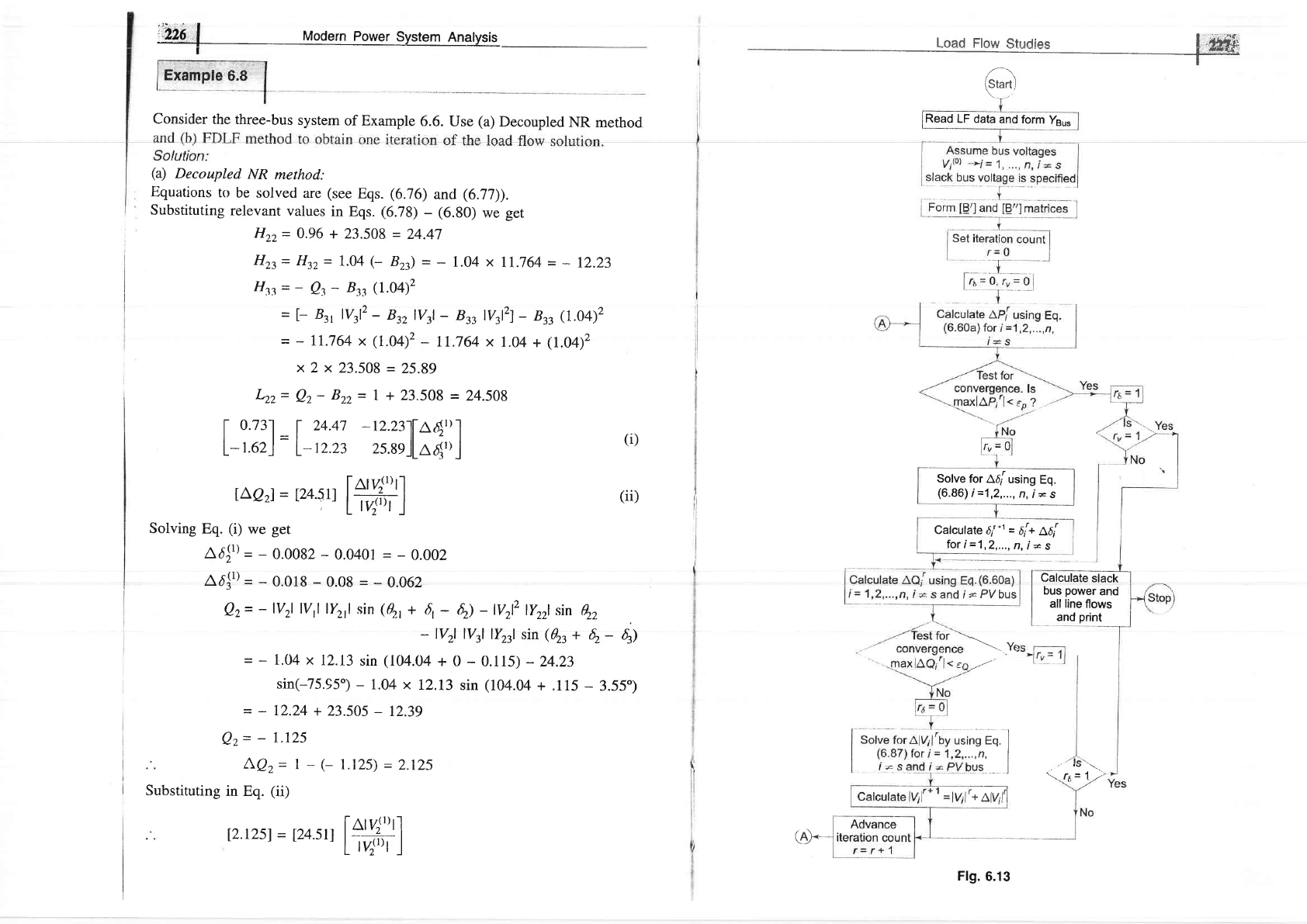
,bZC I
Modern
power
Svstem
Analvsis
Consider
the three-bus
system
of Example
6.6.
Use
(a)
Decoupled
NR
method
(a)
Decoupled
NR method:
Equations
to
be solved
are
(see
Eqs.
(6.76)
and
(6.77)).
Substituting
relevant
values
in Eqs.
(6.78)
-
(6.80)
we
get
Hzz=
0'96
+ 23.508
-
24.47
Hzt=
Hzz=
1.04
(-
Brz)
=
-
1.04
x
11.764
=
-
12.23
Htt=-
Qt-
Bn0.0q2
=
[-
Bsr
t\P
-
42
tv3t
-
Bzz
t\P]
-
Bn
(r.0a1.2
=
-
f
1.764 x
(1.04)2
-
1t.764 x
1.04 +
(l.oq2
x2x
23.508
-25.89
Load Ftow
Studies
I ##
(Start
)
Calculate
6i.1
=
6[+
66[
(i)
(ii)
Lzz
=
Qz
-
Bzz
=
t + 23.508
-
24.508
[
0.731
_
[
24.47
_r2.2311\6t\1
l-t.oz)
-
L-
n.23
zs.ssJ[64trl
tLQzl
-
lz4.srl
f+uJ"'l
'
L
't;(-i)l
J
Solving
Eq.
(i)
we
get
L6;')
=
-
0.0082
-
0.0401
-
-
0.002
Aa{tr
=
-
0.018
-
0.08
-
-
0.062
Qz=
-
lvzl
lvtl lYzl
sin
(0r,
+
6r
-
6r)
-
lvzlz
V2zl sin
82
lvzl
lhl
llrrl sin
(9zt
+
6,
-
q)
=
-
1.04
x
12.13
sin
(104.04
+ 0
-
0.115)
-24.23
sin(-75.95)
-
1.04 x
12.13
sin
(104.04
+
.115
-
3.55")
--12.24+23.505-12.39
Qz=
-
l'125
Ar-l - 1 / 1 1a<\ ^ 1?rE
t-tv2-
r
-
\-
r.rLJ)
=
L.ILJ
Substituting
in Eq.
(ii)
fori=1,2,...,n,i-s
1.
(6.60a)
=
PV
bus
------
X
-'--
I
rcEq.l
.,n,
I
:us-
l
;
Afr/,R
Calculate
sli
bus
power
i
all line
flov
and
print
--
re
\-
<'-
fr= 1 --
l
slack
er
and
flows
e+
Read
LF
data and
form
Ysr.
Solve
for
A6f
using
Eq.
(6.86)
i
=1,2,...,
n,
i
*
s
Lz.rz5r
-
[24.5r]
[alY"(')ll
L
tu,a,
l
Flg.
6.13
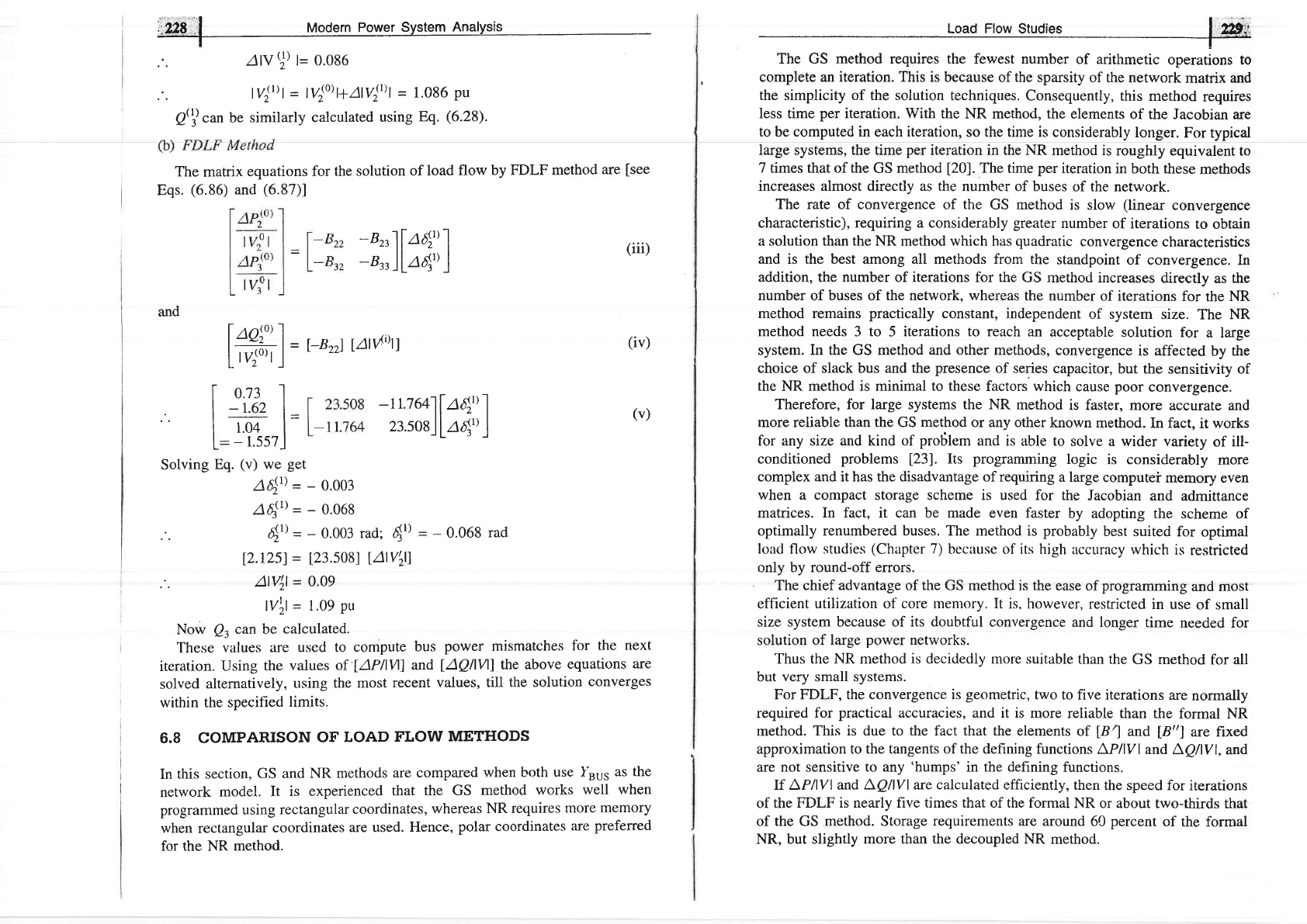
;'..ng
I
Modern
Power
System
Analysis
-
AN
9
l= 0.086
lvftt
-
lvlo)t+atv|'tt
=
1.086
pu
Q(rl
can
be similarly
calculated
using
Eq.
(6.28).
The
matrix
equations
for
the solution
of load
flow
by FDLF
method
are
[see
Eqs.
(6.86)
and
(6.87)l
lui:.
complete an
iteration.
This is because of the
sparsity of
the network
matrix
and
the simplicity of the solution
techniques.
Consequently,
this method
requires
less
time
per
iteration, With
the NR method, the
elements
of the Jacobian are
to be computed in
each
iteration,
so the time is
considerably
longer.
For
typical
large systems, the time
per
iteration in the NR
rnethod is
roughly equivalent
to
7 times
that
of the
GS
method
[20].
The time
per
iteration in
both these
methods
increases
almost
directly
as the
number of buses
of the network.
The rate of convergence
of
the
GS method
is slow
(linear
convergence
characteristic),
requiring
a considerably
greater
number
of iterations
to obtain
a solution than the NR method which has quadratic
convergence
characteristics
and is the best among all methods from
the
standpoint
of convergence. In
addition, the number of iterations for the
GS method
increases
directly
as
the
number
of
buses
of
the network, whereas
the number
of
iterations for
the
NR
method
remains
practically
constant, independent
of system
size.
The
NR
method needs
3 to 5
iterations
to reach an
acceptable
solution for
a large
system.
In the
GS
method and other
methods, convergence
is affected
by the
choice of slack bus
and the
presence
of series
capacitor,
but the
sensitiviry of
the
NR
method is
minimal
to these
factors which
cause
poor
convergence.
Therefore, for large systems the
NR method
is faster,
more accurate
and
more reliable than the GS method or any other
known
method.
In fact,
it
works
for any size and kind of
pro6lem
and
is able to
solve a wider variety
of
ill-
conditioned
problems
t23).
Its
programming
logic
is considerably
more
complex and it has the disadvantage of requiring
a large
computei
memory
even
when a compact storage scheme is used
for the
Jacobian
and admittance
matrices.
In
fact, it can be made even faster
by
adopting the
scheme of
optimally renumbered buses. The method
is
probably
best
suited for
optimal
load
flow
studies
(Chapter
7)
because of its high
accuracy which
is
restricted
only by round-off errors.
The chief advantage of the GS method is
the ease
of
programming
and most
efficient
utilization
of
core menrory.
It is, however,
restricted
in use
of small
size system because of its doubtful convergence
and longer
time
needed for
solution of
large
power
networks.
Thus the NR method is decideclly more suitable
than the
GS method
for
all
but
very
small systems.
For FDLF, the convergence is
geometric,
two
to five iterations
are
normally
required for
practical
accuracies, and it
is more
reliable than the
formal
NR
method.
This is due to the fact that the elements
of
[81
and
[Btt]
are fixed
approximation to the
tangents of the defining
functions
LP/lVl and
L,QAV
l,
and
are not sensitive to any
'humps'
in the ciefining
iunctions.
fi LP/lVl and A^QIIV I are
calculated
efficiently, then
the speed for
iterations
of the FDLF
is nearly five times that of the formal
NR
or about two-thirds
that
of the GS
method.
Storage
requirements are
around
60
percent
of
the formal
NR, but slightly more
than the decoupled NR
method.
-Brr1l
af',f
-8,,
)Lz4"
l
(iii)
and
lffil=
r-Bzzt tatrt')tl
(iv)
fil6411oqrl
23.508.1la4"
l
I
o.tz
I
|
-t.oz
I
t-
|
-
l-
|
1.04
I
L:
-
1'5571
Solving
Eq.
(v)
we
get
46;r)
-
A6t''
=
6')
-
lz.rzsl
-
alvtl
=
lvtt=
-
0.003
-
0.068
-
0.003
rad;
{tl
[23.508]
tatvitl
0.09
1.09
pu
Now
Q3
can be
calculated.
These
values are used
to compute
bus
iteration.
Using
the values
of
'LAPAVll
and
solved
alternatively,
using the
most
recent
within
the specified
limits.
0.068
rad
power
mismatches
for
the
next
lAQAl\l
the above
equations
are
values, till
the solution
converges
(v)
6.8
COMPARISON
OF
IOAD
FLOW
METHODS
In
this section,
GS and
NR methods
are
compared
when both
use
liu5
as the
network
model.
It
is experienced
that
the GS
method
works
well
when
programmed using rectangular
coordinates,
whereas
NR requires
more memory
when rectangular
coordinates
are
used.
Hence,
polar
coordinates
are
preferred
for the NR
method.
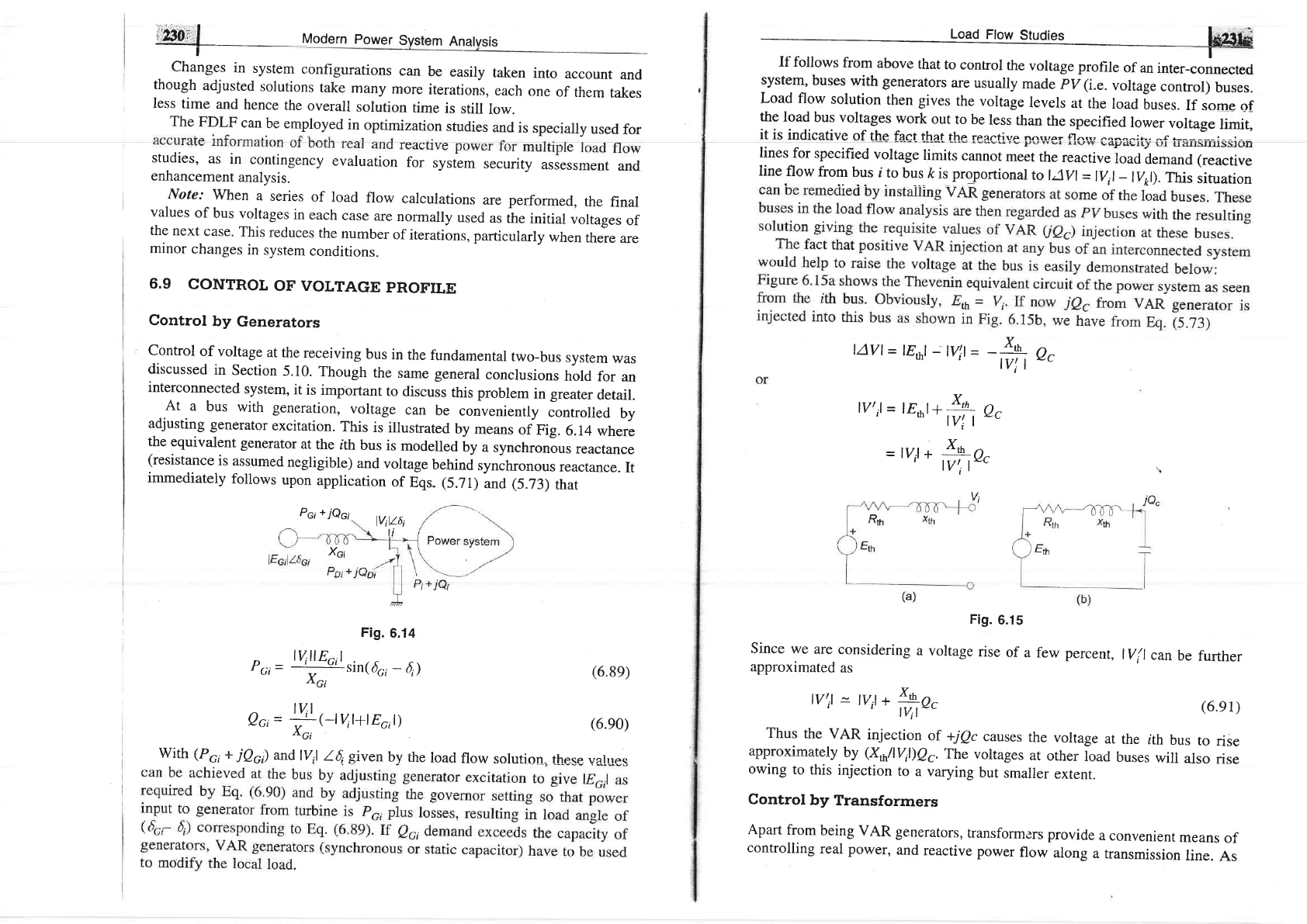
ilai:i;'l
,odern
power
system
Anatvsis
I
Changes
in
system
configurations
can
be
easily
taken
into
account
and
though
adjusted
solutions
take
many
more
iteration.s,
each
one
of
them
takes
less
time
and
hence
the
overall
solution
time
is
still
low.
system,
buses
with generators
are
usually
made
PV
(i.e.
voltage
control)
buses.
Load
flow
solution
then
gives
the
voltage
levels
at
the
load
buses.
If some of
lines
for
specified
voltage
limits
cannot
meet
the
reactive
load
demand
(reactive
line
flow
from
bus
i1o
bus
ft is proportional
to
lAvl
=
lvil
-
lvkD.This
situation
tAvt
-
tEtht
-
tv!
=
-ffi
O,
tv';t=
lErhl+
#l
n,
=tvit*
hn,
Flg.
6.1S
Since
we
are
considering
a
voltage
rise
of
a few
percent,
lV(l
can
be
further
approximated
as
lV|l
=
lV,l+
ffiO,
Thus
the
VAR
injection
of
+jQc
causes
the
voltage
at
the
jth
bus
to
rise
approximately
by
(XhllViDQ..
The
voltages
at
other
load
buses
wili
also rise
owing
to
this
injection
to
a
varying
but
smaller
extent.
Control
by
Transformers
Apart
from
being
VAR
generators,
transformers
provide
a
convenient
means
of
controlling
real power'
and
reactive
power
flow
along
a transmission
line.
As
The
FDLF
can
be
employed
in
optimization
studies
and
is
specially
used
for
the load
bus
voltages
work
out
to be
less
than
the
specified
lower
voltage
limit,
it is
indicative
of the fact that the reer-fivc n^rr/ar ff^.,, ^-*^^ie, ^r4-^-^--:--:-
e
studies,
as
in
contingency
evaluation
enhancement
analysis.
for
system
security
assessment
and
Note:
When
a
series
of
load
flow
calculations
are performed,
the
final
values
of
bus
voltages
in
each
case
are
normally
used
as
the
initial
voltages
of
the
next
case.
This
reduces
the
number
of
iterations,
particularly
when
there
are
minor
changes
in
system
conditions.
6.9
CONTROL
OF VOLTAGE
PROFILE
Control
by
Generators
Control
of
voltage
at
the
receiving
bus
in
the
fundamental
two-bus
system
was
discussed
in
Section
5.10.
Though
the
same
general
conclusions
hold
for
an
interconnected
system,
it
is
important
to
discuss
this
problem
in
greater
detail.
At
a
bus
with
generation,
voltage
can
be
conveniently
controlled
by
adjusting
generator
excitation.
This
is
illustrated
by
means
of
Fig.
6.14
where
the
equivalent
generator
at
the
ith
bus
is
modelled
ty
a
synch.onou,
reactance
(resistance
is
assumed
negligible)
and
voltage
behind
synchronous
reactance.
It
immediately
follows
upon
application
of
Eqs.
(5.71)
and
(5.73)
that
Pai+
jQet
6i
lVilt
ti
Xei
P
c
i
=
|
v,l
-Epl.;;,'
-'-i,
xo,
eci=
#r-,vit+tEcit)
With /P t iA \ --,{ lr/l ,/ f ^:,-^- L-- rr-- r , ft
YYrtrr
\rGi
-
iVcil
ano
i'tlri
Loi
glven
bY-ihe
ioaci
ijow
soiution- these velrres
(6.8e)
(6.e0)
(6.e1)
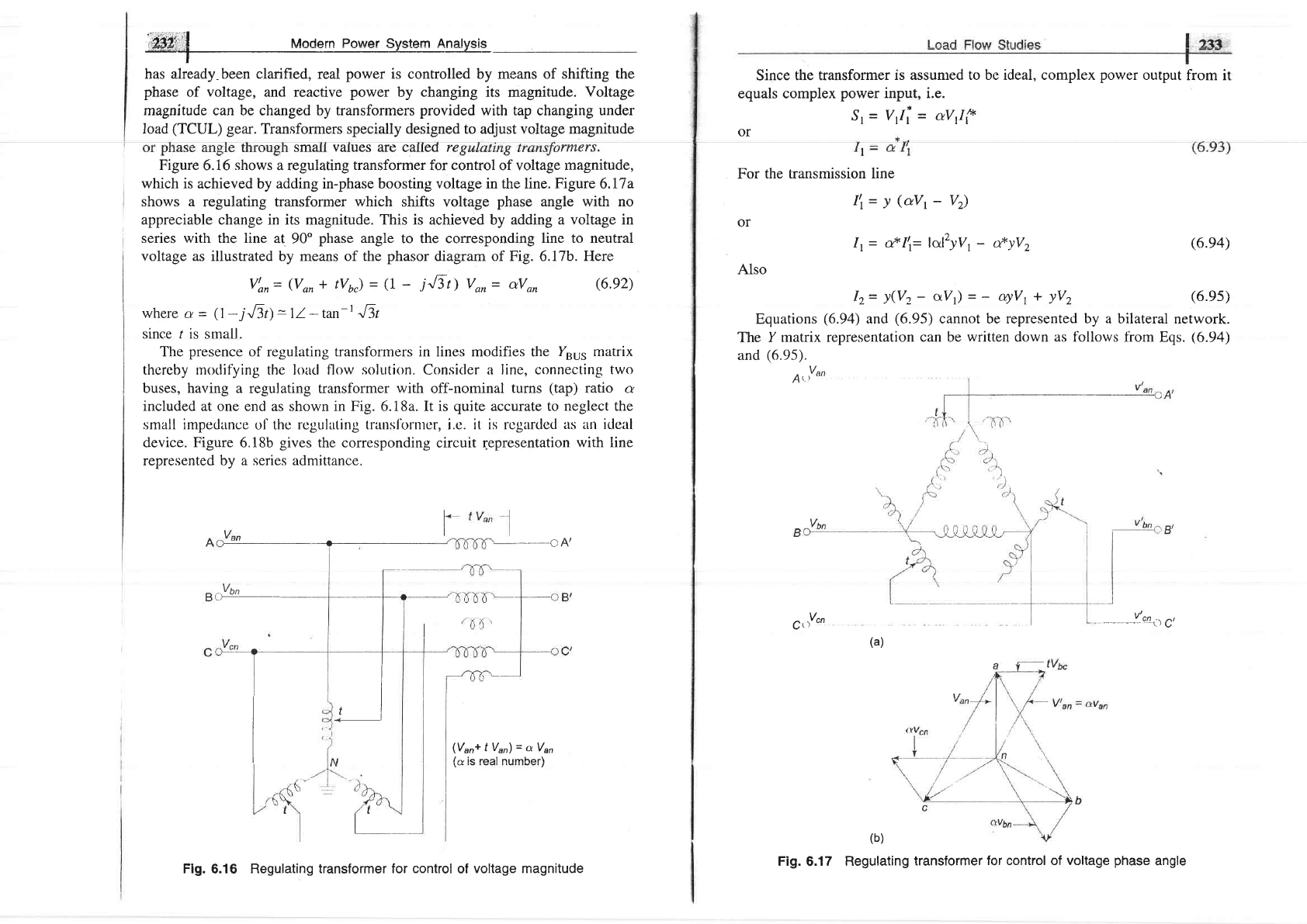
','d&r1'l
Modern
Power
Svstem
A-nalvsis
-l
has
already been clarified,
real
power
is controlled
by means of
shifting the
phase
of
voltage,
and
reactive
power
by
changing
its magnitude.
Voltage
magnitude can be changed by transforrners
provided
with tap changing under
Ioad
(TCUL)
gear.
Transformers specially designed to
adjust
voltage magnitude
smail values are calleo re rnxers.
Figure
6.16
shows
a regulating
transformer
for
control
of voltage
rnagnitude,
which is
achieved by adding in-phase boosting
voltage
in the line.
Figure
6.17a
shows a
regulating transformer
which
shifts voltage
phase
angle with no
appreciable change
in its magnitude.
This
is achieved by
adding a voltage in
series with the line
at
90"
phase
angle
to the corresponding
line to neutral
voltage as illustrated
by means of
the
phasor
diagram
of Fig.
6.17b.
Here
VLn=
(Von
* tV6)
=
Q
-
jJT)
Von= dVon
6.92)
where a
=
(1-jJ-lt)=71-tan-t
J1t
since r is
small.
The
presence
of regulating transformers in lines modifies the
l/uur matrix
thcrcby rn<ilifying the loacl flow
solution.
Consicler
a line, connecting
two
buses, having a
regulating transformer
with
off'-nominal
turns
(tap)
ratio a
included at one end
as shown in Fig. 6.18a. It
is
quite
accurate to neglect the
small
impedance
of the rr:gulating
translonucr,
i.c.
it is rcgardcd
as an iclcal
device.
Figure
6.18b
gives
the corresponding
circuit
4epresentation
with line
represented
by a series admittance.
-_o
A/
Since
the transformer
ls assumed to be ideal, complex
power
output
from it
equals complex
power
input, i.e.
51
=V,/i=
crvlf
or
For
the transmission line
I\=
!
@V1
-
V2)
or
Ir
=
dl'a lo:lzyV,
-
cfyVz
Also
Iz=
l(Vz-
oV,)
=
-
WVr
+
lVz
(6.e4)
(6.es)
Equations
(6.94)
and
(6.95)
cannot be represented by a bilateral network.
The
I matrix
representation
can
be
written down as follows
liom Eqs.
(6.94)
and
(6.95).
n.,%n
C...,%n
.___ Jl"r<_t
c,
(b)
(a)
J
I
(V"n+tV"r)=aV",
/^ ic raal nr rmhor\
Flg.
6.16
Regulating transformer for
control
of
voltage magnitude
Fig.
6.17
Regulating
transformer
for control of voltage
phase
angle
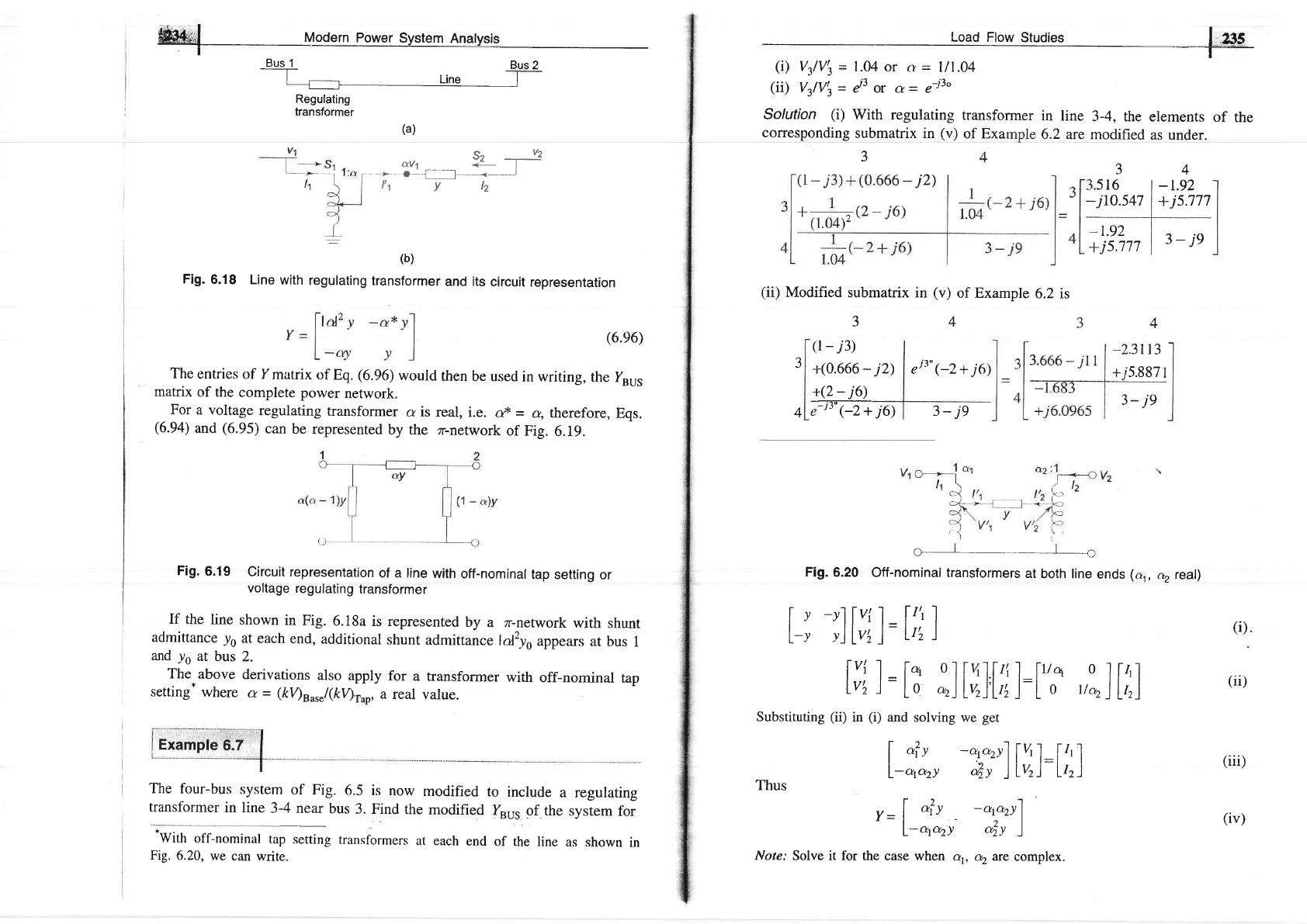
I
Modern
power
System
Analysis
I
Bus,1
Bqs
2
neffiting
transformer
(a)
ao.O
t,o*
a,r.,.r
__
f#
(i)
V/V\
=
l.M or
a
-
l/1.04
(ii)
V/V\
=
d3 or d
=
s-i3o
Solution
(i)
With regulating
transformer
in line
3-4, the
elements
of
the
6.2 are modified
as under.
corresponding
submatrix in
(v)
of Exa
sz
v2
aV'l <L
I
. ---.-
O--f__1--*-<-
I
l''r
Y
12
(b)
Fig.
6.18
Line
with
regulating
transformer
and its
circuit
representation
The
entries
of f
matrix
of Eq.
(6.96)
would
then
be used
in
writing,
the rru,
matrix
of the
complete power
network.
For
a voltage
regulating
transformer
a
is real,
i.e.
d
=
e, therefore,
Eqs.
(6.94)
and
(6.95)
can
be
represenred
by the
zr-network
of Fig.
6.19.
Fis.6.1e
:jiiil:':3;:i;ffiTH#*:
with
orr-nominar
tap
settins or
If
the
line
shown
in Fig.
6.18a
is represented
by
a zr-network
with shunt
admittance
yu
at each
end,
additional
shunt
admittancelol2ysappears
at
bus
1
and
yo
at
bus 2.
The
above
derivations
also
apply
for
a transformer
with
off-nomin
al
tap
setting'
where
a
=
(k[nuJ(kD,r:up,
a real
value.
The
four-bus
system
of Fig.
6.5
is
now
modified
to
include
a regulating
transformer
in line
3-4 near
bus
3. Find
the
modified
rru5
gf
the
system
for
-With
off-nominaf
,up
**ing
transformers
at each
end
of the
line
as
shown
in
Fig.
6.20,
we can
write.
tc
Fig.
6.20
Off-nominal
transformers
at
both line
ends
(a.,
,
a, real)
I
t
-Ylfvil-[Ii-l
L-,
y)lvt
)-
Ut
)
ly.i 1=[o,
oI[-'4.llrl
I lt/q
o
If4l
Lv;l-lo
q)Lv,)'L,;l:[
o
v",)],1
Substituting
(ii)
in
(i)
and solving we
get
|
4t
-"!-',vf
[q 1: ['"1
L-otory
4y
)
LV2
J ltz )
--l
o?v
-aqztf
'=
l-^*,
d;
)
Note:
Solve it for the
case when
ao
&2
are
complex.
3
4
-r.92
+
js.777
3-je
(6.e6)
j2)
j6)
a
J
r-
j3)
-(0.666
-
-(2
-
j6)
1T
Gz+
3
4
j6)
4
i3"
e2
+
3-
je
3-
je
3.
e
(i)
.
(ii
)
/iii\
Thus
(iv)
516
j10.s47
r.92
js.777
of Example
6.2 is
j2)
in(
3
Modified
submatrix
(v)
4
.3r13
5.887
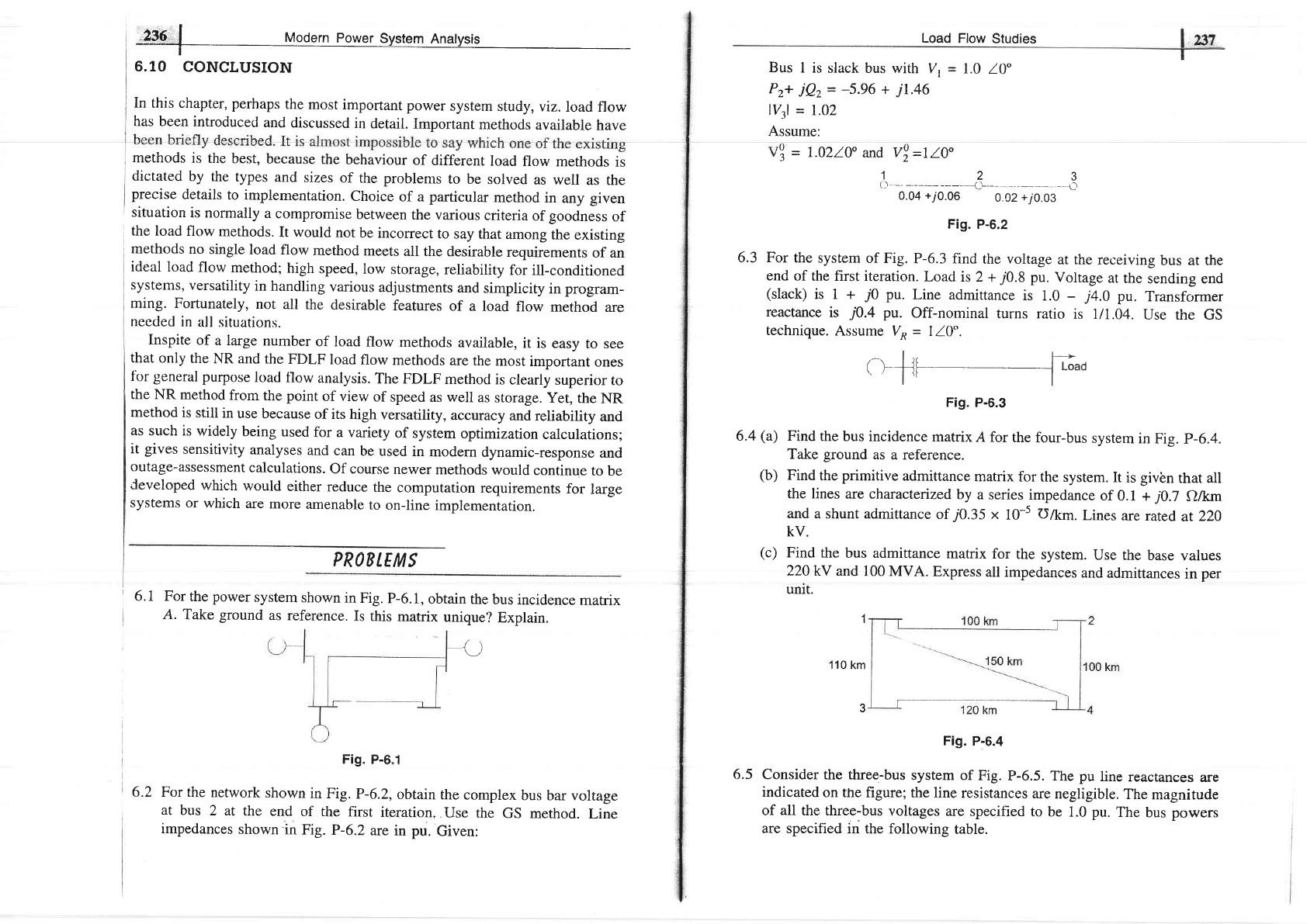
.l
236
|
Modern
power
System
Anqtysis
I
6.10
CONCLUSION
In
this chapter,
perhaps
the
most
important
power
system
study,
viz.
load flow
has
been introduced
and
discussed
in
detail.
Important
methods
available
have
methods
is
the
best,
because
the
behaviour
of different
load
flow
methods
is
dictated
by
the
types
and
sizes
of the problems
to
be
solved
as
well
as the
precise
details
to implementation.
Choice
of a
particular
method
in
any
given
situation
is
normally
a
compromise
between
the various
criteria
of
goodness
of
the load
flow
methods.
It would
not
be incorrect
to
say that
among
the
existing
methods
no
single
load
flow
method
meets
all the
desirable
requirements
of an
ideal
load
flow
method;
high
speed,
low
storage,
reliability
for
ill-conditioned
systems,
versatility
in
handling
various
adjustments
and
simplicity
in
program-
ming. Fortunately,
not
all
the
desirable
features
of a
load
flow
method
are
needed in
all situations.
Inspite
of
a large
number
of load
flow
methods
available,
it is
easy
to see
that
only
the
NR and
the
FDLF
load
flow
methods
are
the
most
important
ones
fbr general
purpose
load
flow
analysis.
The
FDLF
method
is
clearly
superior
to
the
NR method
from
the point
of
view
of speed
as well
as
storage.
Yet, the
NR
method
is
stili
in use
because
of its
high
versatility,
accuracy
and
reliability
and
as
such is
widely
being
used
for a variety
of system
optimization
calculations;
it
gives
sensitivity
analyses
and
can
be used
in
modern
dynamic-response
and
outage-assessment
calculations.
Of course
newer
methods
would
continue
to be
developed
which
would
either
reduce
the
computation
requirements
for
large
systems
or
which
are
more
amenable
to
on-line
implementation.
PROB
TE
IVI S
For
the power
system
shown
in
Fig.
P-6.1,
obtain
the
bus
incidence
matrix
A.
Take ground
as
reference.
Is this
matrix
unique?
Explain.
(-)
Fig.
p-6='!
F<rr the
network shown
in Fig.
P-6.2,
obtain
the
complex
bus
bar voltage
at
bus
2 at
the
end
of the
first
iteration..use
the
GS
method.
Line
impedances
shown
in
Fig.
P-6.2
are
in
pu.
Given:
Load
Flow
Studies
Bus
I is
slack bus with
Vr
=
1.0 10"
Pz+
iQz
=
-5.96
+
j1.46
lVTl
=
1102
Assume:
\
=
1.02/0"
and vi
-710"
123
t-'
o
ottooo
tt.-o.oz
.7orr:"
Fig.
P-6.2
6.3
For
the
system
of Fig.
P-6.3
find
the
voltage
at the
receiving
bus at the
end of the first
iteration.
Load
is 2
+
70.8
pu.
voltage
at
the
sending end
(slack)
is 1 +
/0
pu.
Line
admittance
is
1.0
-
74.0
pu.
Transformer
reactance
is
70.4
pu.
off-nominal
turns ratio
is lll.04.
Use the GS
technique.
Assume
Vn
=
ll0.
c>+J=---F"d
Fig.
P-6.3
6.4
(a)
Find
the
bus incidence
matrix
A
for the
four-bus
sysrem
in
Fig.
p-6.4.
Take
ground
as a reference.
(b)
Find
the
primitive
admittance
matrix
for the
system.
It
is
givbn
rhat all
the lines
are charactenzed
by
a series
impedance
of
0.1 +
j0.7
akrn
and
a shunt admittance
of
70.35
x
10-5
O/km.
Lines
are
rated
at220
kv.
(c)
Find the
bus admittance
matrix
for
the
system.
Use the
base
values
22OkV and
100
MVA. Express
all impedances
and admittances
in
per
unit.
6.r
6.5
1
110
km
3
Fig.
P-6.4
Consider
the three-bus
system
of
Fig.
P-6.5. The
pu
line
reactances
are
indicated
on the figure;
the line
resistances
are
negligible.
The
magnitude
of
all
the three-bus
voltages
are specified
to be
1.0
pu.
The
bus powers
are specified
in the
following
table.
6.2
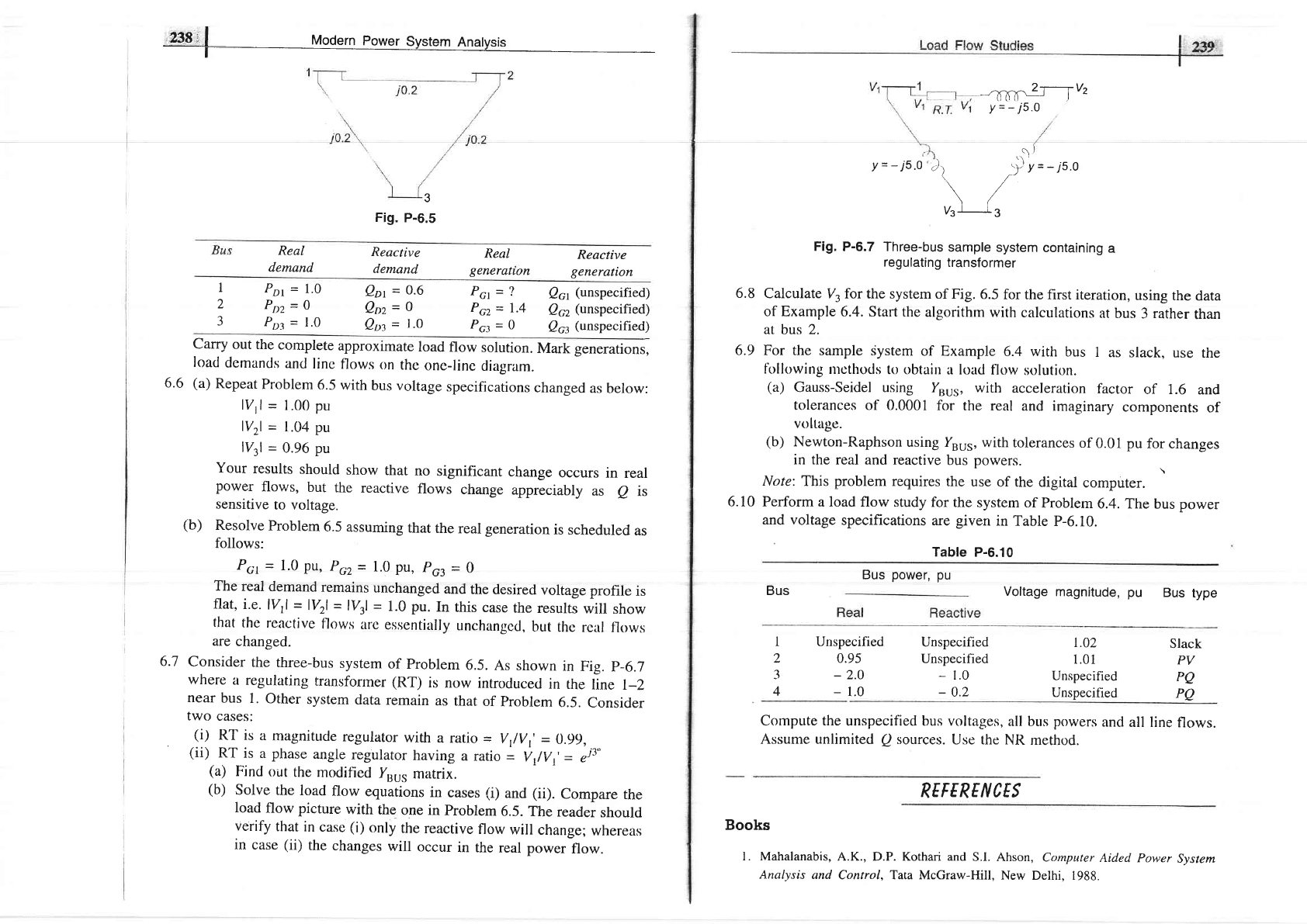
.?38 i
I
Modern
Power
Svstem
Anatvsis
I
3
Fig.
P-6.5
.ffi
Z-r----rvz
--
()
ir o
--
|
y=_j5.0
',\
,lJ
,
=
-is'o
\/
vel
13
Fig.
P-6.7 Three-bus
sample
system
containing
a
regulating
transformer
6.8
Calculate
V3for the system
of Fig.
6.5
for the
first iteration,
using
the
data
of Example
6.4. Start the
algorithm
with
calculations
at
bus
3
rather
than
at bus 2.
6.9 For the
sample system
of Example
6.4 with
bus
I
as
slack, use
the
fbllowing
nrcthuds
to obtairr
a load
flow
solution.
(a)
Gauss-Seidel using
luur,
with
acceleration
factor
of 1.6
and
tolerances of 0.0001
for
the real
and imaginary
components
of
voltuge.
(b)
Newton-Raphson
using IBUS,
with
tolerances
of
0.01
pu
for
changes
in the real
and
reactive bus powers.
\
Note:
This
problem
requires
the
use
of the digital
computer.
6.10 Perform
a load flow study
for
the system
of
Problem
6.4.
The bus power
and voltage
specifications
are
given
in Table
P-6.10.
Table
P-6.10
Bus
power,
pu
Bus
Voltage
magnitude, pu
Bus
type
y=-j5
0
,l
Real
demand
Reactive
demand
Real
Seneratrcn
Reactive
generation
I
Por
=
1.0
Qot
=
0.6
PGr
=
?
ect
(unspecified)
'
',r2
=
0
Qoz
=
0
Pcz
=
1.4
pn,
lunspecified)
3
Po:
=
1.0
Qot
=
l.O
Pa
=
0
go.
lunsp"cified)
Carry
out
the
complete
approximate
load
flow
solution.
Mark generations,
load
demands
and
linc
f-lows
on
thc
one-line
diagram.
6.6
(a)
Repeat
Problem
6.5
with
bus voltage
specifications
changed
as
below:
lVtl
=
1.00 pu
lV2l
=
1.04 pu
lV3l
=
0.96
pu
Your
results
should
show
that
no
significant
change
occurs
in
real
power
flows,
but
the
reactive
flows
change
appreciably
as
e
is
sensitive
to voltage.
(b)
Resolve
Problem
6.5
assuming
that
the
real generation
is
scheduled
as
follows:
Pct
=
1.0 pu,
Pcz
=
1.0
pu,
Pct
=
0
The
real
demand
remains
unchanged
and
the
desired
voltage
profile
is
flat,
i.e.
lvrl
=
lv2l
=
lv3l
=
1.0
pu.
In
this
case
the
results
will
show
that
the reactive
flows
arc
essentially
unchangccl,
but
thc
rcal
flgws
are
changed.
6.7
Consider
the
three-bus
system
of
problem
6.5.
As
shown
in
Fig.
p-6.7
where
a
regulating
transforrner
(RT)
is
now
introcluced
in
the
ljne
l-2
near
bus
1.
Other
system
data
remain
as
that
of
Problem
6.5.
Consider
two
cases:
(i)
RT is
a
magnitude
regulator
with
a rario
=
VrlVl
=
0.99,
(ii)
RT
is
a
phase
angle
regr-rlaror
having
a
ratio
=
V/Vi
=
",3"
(a)
Find
out
the
modified
)/ur5
matrix.
(b)
Solve
the
load
flow
equations
in
cases
(i)
and
(ii).
compare
the
load
flow picture
with
the
one in
Problem
6.5.
The
reader
should
verify
that
in
case
(i)
only
the
reactive
flow
will
change;
whereas
in case
(ii)
the
changes
will
occur
in
the real power
flow.
Compute the
unspecified bus voltages,
all
bus powers
and
all line
flows.
Assume unlimited
Q
sources.
Use the
NR method.
REFERE
N CES
I
2
a
-)
4
Unspecified
0.95
-
2.O
-
1.0
Unspecified
Unspecified
-
1.0
-
0.2
1.02
1.01
Unspecified
Unspecified
Slack
PV
PQ
PQ
Books
l. Mahalanabis,
A.K., D.P. Kothari and
S.I.
Analysis
and
Control, Tata McGraw-Hill,
Ahson,
Computer
Aided
Power
System
New
Delhi. 1988.
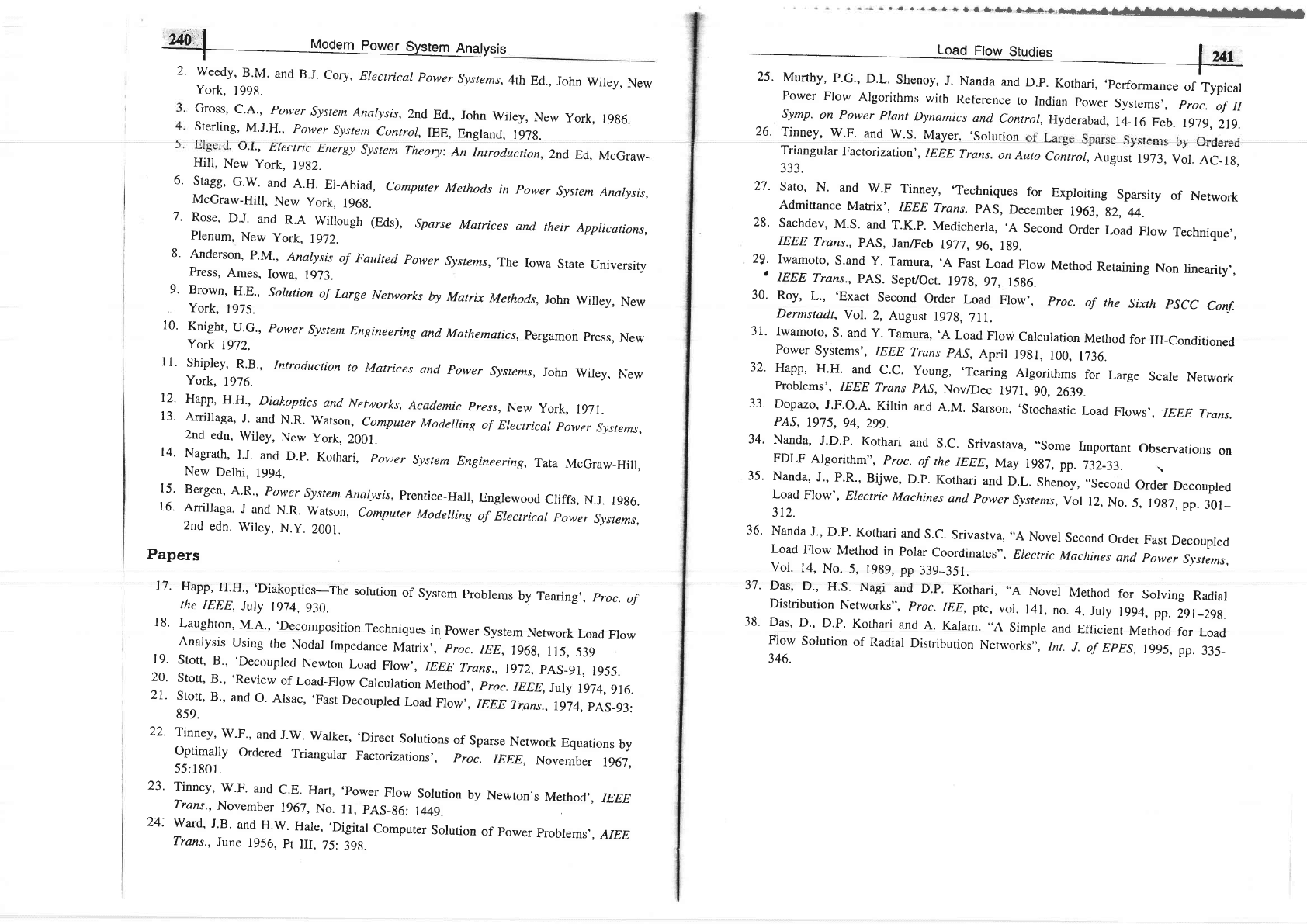
,
u.r.,
L,teclrrc
Lnergy
System
Theom:
An
Introduction,
2nd
Ed,
McGraw_
Hill,
New
York.
19g2.
6.
stagg,
G.w.
and
A.H.
EI-Abiad,
computer
Methods
in
power
system
Anarysis,
McGraw-Hill,
New
york,
196g.
7
'
Rose'
D'J'
and
R'A
willough
(Eds),
sparse
Matrices
and
their
Applications,
Plenum,
New
york,
1972.
8'
Anderson,
P'M.,
Analysis
of
Faulted
Power
systems,
The
Iowa
state
university
Press,
Ames,
Iowa,
1923.
9'
Brown,
H'8.,
sorution
of
Large
Networks
by
Matix
Methods,
John
w1rey,
New
,
York,
1975.
l0'
Knight'
rJ'G',
Power
system
Engineering
and
Mathematics,
pergamon
press,
New
York
1972.
11.
Shipley,
R.B.,
Introduction
to
Matrices
and
power
systems,
John
w1ey,
New
York,
1976.
12'
Hupp,
H.H.,
Diakoptics
and
Networks,
Academic
press,
New
york,
1971.
l3'
Arrillaga,
J.
and
N.R.
watson,
computer
Modeiling
of
Erectricar
power
sltstems,
2nd
edn,
Wiley,
New
york,
2001.
14'
Nagrath,
I.J.
and
D.p.
Kothari,
power
system
Engineering,
Tata
McGraw_Hilr,
New
Delhi,
1994.
l5'
Bergen,
A.R.,
power
system
Anarysis,
prentice-Hail,
Engrewood
criffs,
N.J.
r9g6.
l6'
Anillaga'
J
and
N'R'
watson,
computer
Modelting
of
Electrical
power
systems,
2nd
edn.
Wiley,
N.y.
2001.
Papers
'
2A0"'l
Modprn
pnrrrar
errara* A^^r-.-,-
_-r____
.-.---',,
,
v'rvr
eyorrrill
A1 tatysls
2'
weedy,
B.M.
and
B.J.
cory,
Erectricar
power-
systents,4th
Ed.,
John
wiley,
New
York,
1998.
Gross,
C.A.,
power
System
Analysis,
2nd
8d..,
Sterling,
M.J.H.,
power
System
Control,
IEE.
17.
Happ,
H.H.,
'Diakoptics-The
solution
of
system
problems
by
Tearing
,,
proc.
of
the
IEEE,
Juty
t974,
930.
l8'
Laughton'
M'A',
'Decontposition
Techniques
in
power
system
Network
Load
Flow
Analysi.s
usi'g
the
Nodar
Impcdance
Matrix,,
proc.
IEE,
196g,
r15,
s3g
19'
stott,
B.,
'Decouprecr
Newron
Load
FIow,,
IEEE
Trans.,
1972,
pAS_91,
1955.
20.
stott,
B.,
'Review
of
Load-Frow
carcuration
Method,
,
proc.
IEEE,
Jury
1974,916.
21'
stott,
B.,
and
o.
Alsac,
'Fast
Decoupled
Load
Flow,,
IEEE
Trans.,
1974,pAS_93:
859.
22'
Tinney'
w'F"
and
J'w.
walker,
'Direct
solutions
of
sparse
Network
Equations
by
Optimally
Ordered
Triangular
Factorizaiions,,
proc.
IEEE. Nnvernhe" 1oA1
55:1801
'v
"
23'
Tinney,
w.F.
and
c.E.
Hart,
'power
Flow
sorution
by
Newton,s
Method,,
,EEE
Trans.,
November
1967,
No.
ll,
pAS_g6:1449.
24'
ward,
J.B.
and
H.w.
Hare,
'Digitar
computer
Sorution
of
power
problems,,
AIEE
Trans.,
June
1956,
pt
III,
75:
39g.
Power
Frow
Argorithms
with
Reference
to
Indian
power
systems,,
proc.
of II
symp.on
Power
plant
Dynamics
ancr
contror,
Hyderabad,
14_i6
Feb.
rg:/g,
zrg.
26.
Tinney,
W.F.
and
W.S.
Mayer,
.Solution
Triangular
Factorization',
IEEE
Trans.
on
Auto
contor,
August
1973,
yor.
AC_lg,
JJJ.
27 '
Saro,
N.
and
w.F
Tinney,
'Techniques
for
Exproiting
Sparsity
Admittance
Matrix',
IEEE
Trans.
pAS,
I)ecember
L963,
g2,
44.
28'
sachdev,
M.s.
and
r.K.p.
Medicherla,
'A
second
order
Load
Flow
IEEE
Trans.,
pAS,
Jan/Feb
1977,
96,
Lgg.
29.
Iwamoto,
S.and
y.
Tamura,
,A
Fast
Load
Flow
Method
'
IEEE
Trans.,
pAS.
Sept/Oct.
197g,
97,
15g6.
30.
Roy,
L.,
'Exact
Second
Order
Load
Flow,,
proc.
of
Dermstadt,
Yol.
2,
August
lg7g,
7Il.
31'
Iwamoto,
s' and
Y.
Tamura,
'A
Load
Flow
calculation
Method
for
Ill-conditioned
Power
Systems',
IEEE
Trans
pAS,
April
lggl
,
100,
1736.
32.
Happ,
H.H.
and
c.c.
young,
'Tearing
Argorithms
for
Large
scare
Network
Problems',
IEEE
Trans
pA,S,
Nov/Dec
Ig71,
gO,
2639.
33.
Dopazo,
J.F.O.A.
Kiltin
and
A.M.
Sarson,
,stochastic
Load
Flow
s,,
.IEEE
Trans.
PAS,
1975,94,2gg.
34'
Nanda'
J'D'P'
Kothari
and
s.c.
srivastava,
"Some
Important
observations
on
FDLF'Algorithm",
proc.
of
the
IEEE,
May
19g7,
pp.732_33.
\
35.
Nanda,
J.,
p.R.,
Bijwe,
D.p.
Kothari
and
D.L.
stenoy,
.,second
order
Decoupred
Load
Flow',
Erectric
Machines
and
power
systems,
vor
r2,
No.
5,
19g7,
pp.
301_
312.
36'
Nanda
J''
D'P'
Kothari
and
S.c.
srivastva,
"A
Novel
second
order
Fast
Decoupled
Load
Flow
Method
in
Polar
coordinatcs",
Electic
Machines
and
power,s.ysrems,
Vol.
14,
No.
5,
19g9,
pp
339_351
37.
Das,
D.,
H.s.
Nagi
and
D.p.
Kothari,
.,A
Novel
Method
for
solving
Radiar
Distribution
Networks",
proc.
IEE,
ptc,
v.r.
r4r,
no.
4.
Jury
r994.
pp.
zgr_zgg.
38'
Das,
D',
D'P'
Kothari
and
A.
Kalam.
"A
Simple
and
Efficient
Method
for
Load
Flow
sorurion
of
Radiar
Distribution
Nerworks',,
Inr.
J.
of
EpES,
r995,
pp.
335_
346.
John
Wiley,
New
york,
19g6.
England,
1978.
of
Network
Technique',
Retaining
Non
linearitv'.
the
Sixth
pSCC
Conf.
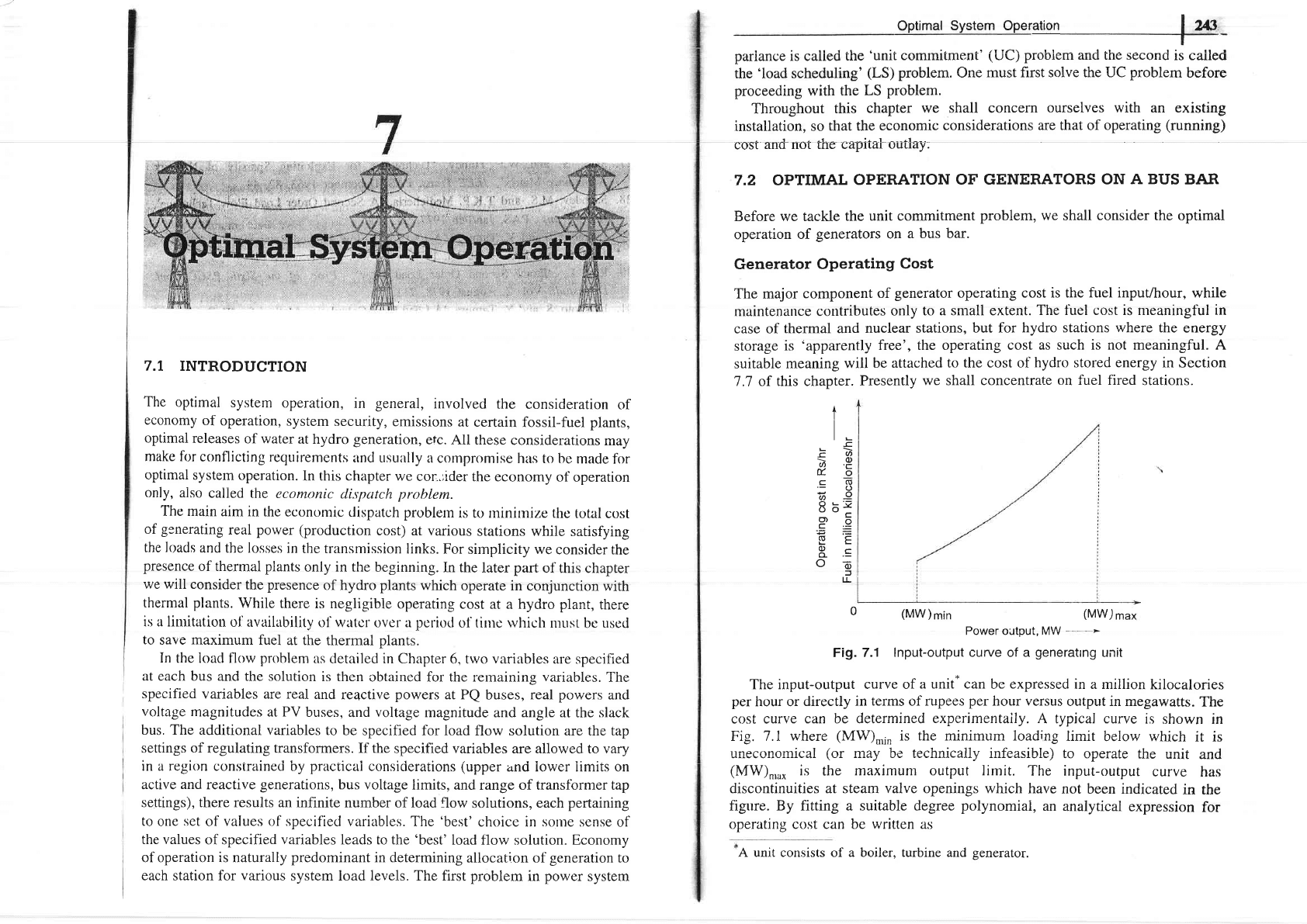
7.1
INTRODUCTION
The
optimal
system
operation,
in
general,
involved
the
consideration
of
economy
of
operation,
system
security,
emissions
at
certain
fossil-fuel
plants,
optimal
releases
of
water
at hydro
generation,
etc.
All these
considerations
may
make
for conflicting
requirements
and usually
a
compromise
has fo he
made
for
optimal
system
operation.
ln this chapter
we
cor..;ider
the economy
of operation
only, also
called the
ec'omonic
di.spcttch
problem.
The
main aim
in the economic
dispatch problern
is to rninimize thc
total
cost
of
generating
real
power (production
cost) at various
stations while
satisfying
the loads
and the
losses in
the transmission
links.
For
sirnplicity we
consicler the
presence
of thermal plants
only in the
beginning.
In the
later
part
of this chapter
we
will
consider
the
presence
of hydro
plants
which
operate in
conjunction
with
thermal
plants.
While there
is negligible
operating
cost at
a hydro
plant,
there
is a limitation
ol availability
ol'watcr'
over a
pcriod
of tinre
which
nrust
bc
used
to
save maximum
fuel at the
thermal
plants.
In
the load
flow
problem
as
detailed in Chapter
6, two
variables
are specified
at each bus
and the solution
is then
obtained for the rernaining
variables.
The
specified
variables are real
and
reactive
powers
at PQ
buses, real
powers
and
voltage
magnitudes at PV
buses,
and
voltage
magnitude
and
angle
at the
slack
bus. The additional
variables to
be specified for load
flow solution are the tap
settings
of
regulating transformers. If the
specified
variables are allowed to vary
in a region constraineci
by
practicai
consicierations
(upper
anci iower iimits on
active
and
reactive
generations,
bus voltage
limits,
and range of transformer tap
settings), there results
an infinite number
of load flow
solutions,
each
pertaining
to
one
set
of
values
o1'specified variables. The
'best'
choice in sorne sense
of
the values
of specified
variables
leads
to the
'best'
load
flow solution.
Economy
of operation is naturally
predominant
in determining
allocation of
generation
to
each station for various
system load levels. The first
problem
in
power
system
Optimal
System Operation
A3
pariance is
caiied
the
'unii
commitment'
(UC)
probiem
and the second
is calleci
the
'load
scheduling'
(LS)
problem.
One
must first solve the UC
problem
before
proceeding
with
the
LS
problem.
Throughout
this
chapter
we shall concern
ourselves
with
an existing
installation,
so
that the
economic
considerations are that of operating
(running)
cost
and not the capitai
outiay.
7.2
OPTIMAL
OPERATION
OF GENERATORS
ON
A BUS
BAR
Before we tackle
the
unit commitment
problem, we
shall
consider
the optimal
operation
of
generators
on
a bus bar.
Generator
Operating
Cost
The major
component
of
generator
operating cost is the
fuel input/hour,
while
maintenance coutributes
only to
a small extent.
The fuel cost is meaningtul
in
case of
thermal and
nuclear stations,
but for
hydro stations
where
the
energy
storage
is
'apparently
free', the operating cost
as such is not meaningful. A
suitable
meaning
will
be attached
to the cost of hydro stored
energy
in Section
7.7 of this chapter.
Presently
we
shall
concentrate
on fuel fired
stations.
o
(vw)min (MW)max
Power output, MW
-'- --
Fig.7.1
Input-output curve of a
generatrng
unit
The input-output
curve of
a unit* can
be
expressed
in a million
kilocalories
per
hour or
directly in
terms
of
rupees
per
hour versus
output in megawatts.
The
cost curve
can be determined
experimentaily.
A typical curve
is
shown in
Fig. 7.1
where
(MW)o'in
is the minimum loading
limit
below which
it
is
uneconomical
(or
may be technically infeasible)
to operate
the
unit
and
(MW)n,u,
is
the
maximunr output limit.
The inpLlt-output
curve
has
discontinuities at steam valve openings which
have not
been indicated
in the
figure. By fitting a suitable degree
polynomial,
an
analytical
expression
for
operating cost can be written as
l
I
I
I
t-
L\
- al)
;P
tro
.c8
6o
8 b=
e5
gE
o
O6
f
LL
A unit consists of a boiler, turbine and
generator.
